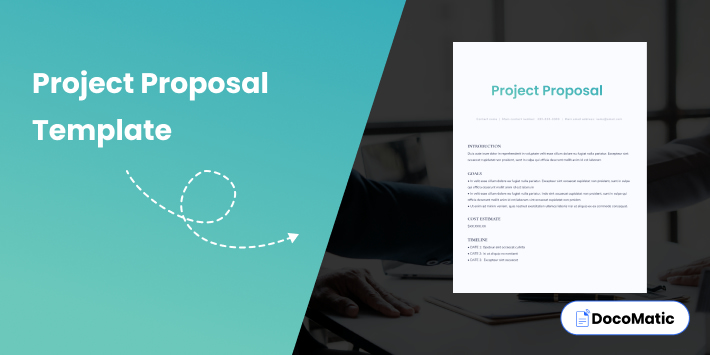Whether you are starting your business venture, carrying out a research study, or initiating any other project, having an effective proposal for your project is important. In simple words, a project proposal is a formal document that shows the ins and outs of the project.
Project proposals are plans that define or outline what you want to do, how you plan to accomplish it, and why it is worth it. It is an essential tool for raising money, forming partnerships, and persuading stakeholders of the value and viability of your idea.
Making a successful proposal can be challenging, especially if you have never done it before. This blog post will offer a step-by-step tutorial on how to create a project proposal that will be accepted, as well as tips for making it stand out from the crowd and a project proposal template to make you on the go.
Table of Content
What is a Project Proposal?
It is a document that is drafted and sent to potential clients, sponsors, or investors for approval with the intention of getting funding, support, or approval for the project.
A proposal should have all key details about the project, including the problem or the opportunity that the project addresses, the goals and objectives of the project, the scope of the project, the expected time to complete the project, the budget, and resources required, and any possible challenges.
To make an appealing project proposal, you must include the reasons that make the project worth pursuing and also state how it will benefit the stakeholders. The project proposal should be clear, concise, and convincing so it would make a strong reason for why the project should be funded or supported.
Types of Project Proposals
Based on the nature, scope, and purpose of the project, there are 5 major types of project proposals:
1. Solicited project proposals
The solicited project proposals are requested by clients or customers who are actively looking for quotations from potential vendors or contractors. In this sort of proposal, the client often submits a Request for Proposal (RFP) or Request for Quotation (RFQ) outlining their specific needs, objectives, and assessment criteria.
The proposal should address all of the requirements outlined in the RFP or RFQ and show how the proposed solution fulfills the demands of the client. An unsolicited proposal is usually less structured and formal than a solicited proposal.
2. Unsolicited project proposals
These proposals are those that are sent to a potential client or customer without their prior request. The objective of an unsolicited project proposal is to present the proposer’s products, services, or ideas to the client and persuade them to consider them.
Unsolicited proposals should clearly outline the client’s needs or challenges and show how the proposed solution will address them. This form of proposal necessitates more imagination and persuasive writing abilities than a solicited proposal.
3. Continuation project proposals
Continuation project proposals are most commonly utilized in multi-year projects or those with agreed-upon conditions governing how the project develops. The purpose of the continuation project proposals, unlike other proposals, is to keep the customer informed about the project’s progress. These proposals also offer any project-related necessary metrics or scope of work updates and obtain formal clearance to continue with the project.
A continuation proposal should include an executive summary outlining the project’s current status, any accomplishments, and milestones achieved during the previous phase.
4. Renewal project proposals
Renewal project proposal is similar to a continuation proposal, but it focuses on renewing or refreshing an existing project that has previously been completed or discontinued. This form of proposal is frequently used to revive or upgrade a previously successful project that has been inactive for some time. The project management proposal should detail the project’s previous accomplishments and demonstrate the need for and possible advantages of project renewal.
5. Supplemental project proposals
A supplemental project proposal is one that asks for more funds or support for an existing project. This sort of proposal is frequently made after the project has begun and additional cash or resources are required to finish it. The proposal should clearly indicate why more finances or resources are required, as well as how they will be used to meet the project’s goals.
8 Steps to Write an Attractive Project Proposal
To curate a professional and good-looking project management proposal for your project, you must follow a project proposal format. It should be so detailed that your potential clients can’t keep themselves from accepting the proposal. Follow the below-given 8 steps to create a professional-looking project proposal:
Step-1: Executive summary
The executive summary gives the reader a quick overview of the proposal so they can quickly comprehend its purpose. It needs to be an attention-grabbing summary that highlights the proposal’s important features and draws the reader in. Basically, it is a project proposal outline that should include the following:
- Explain the ins and outs of the project in a nutshell,
- A brief description of the problem or opportunity
- Summary of your proposed solution
- Summary of the expected results and benefits
Step-2: Project Background
This section provides context for the project proposal. It should outline the problem the project aims to resolve, the background of the problem, and any other relevant details that would assist the reader in appreciating the necessity of the project. Precisely, the project background section should include:
- An explanation of the importance of the problem, and why it should be addressed
- History of the problem or opportunity
- Relevant statistics or data that support the need for the project
Step-3: Objectives
In the objectives section of your proposal writing, you have to enlist all the project objectives and goals. There should be clear and concise information of what are the aims of the proposed project. The objectives should be SMART – Specific, Measurable, Achievable, Relevant, and Time-bound. The objectives section should have:
- A list of the project’s objectives and goals
- An explanation of how the project will accomplish its goals
Step-4: Methodology
In the methodology section, the project’s approach, and methods for achieving its goals are described. It should contain a thorough explanation of the project’s methodology, including the procedures, resources, and other project management tools that will be used. In the methodology section, you should include:
- A detailed description of the project’s approach
- The methodology, tools, and procedures used
- A brief of how you will apply the methods
- Time required to make the implementation
Step-5: Deliverables
The project’s observable results are described in the deliverables section. A list of the products, services, or outcomes that will be provided as part of the project should be included. Some of the inclusions in the project deliverables are
- A list of products or services you will deliver during the course of the project
- A timeline to complete the deliverables
Step-6: Project Budget
The project’s costs are described in the project budget section. You should include a thorough breakdown of all project costs, including labor, supplies, machinery, and any additional expenses, to ensure transparency between you and the potential client regarding the budget of the project. Things to include in the project budget section are
- A detailed breakdown of the costs involved in the project
- How you will manage and control the costs
Step-7: Evaluation
In the evaluation section, you will have to outline how the evaluation of the project will take place and how you will measure its success. You should include a strategy for tracking progress toward the goals and evaluating the project’s overall success. In the evaluation section, you should include:
- A plan on how you will evaluate the success of the project
- A timeline for the evaluation process
- A description of who will be responsible for the evaluation process
Step-8: Conclusion
The summary of the proposal’s main features should be followed by a convincing argument for the project’s approval. It ought to contain a call to action and a concise description of the next steps. In the conclusion section, you should include:
- A gist of the project details
- Summary of problems and solutions
Tips to Consider While Writing a Project Proposal
To make an informed project proposal, make sure you follow the below-given tips:
Know your audience
Make certain you are aware of your target audience and what they are seeking in a proposal. Make sure your proposal satisfies their requirements and expectations.
Keep it concise
Your proposal must be concise and precise, concentrating on the most crucial information. Don’t mislead your readers by utilizing jargon or other technical terms.
Be realistic
Be sure that the different project ideas, budgets, schedules, and project scope in your proposal are realistic. Stay away from overcommitting or making false promises.
Proofread and edit
Once you write a project proposal, make sure that someone from your project team thoroughly edited and proofread it before submitting it. By doing this, you can ensure that your proposal is polished and free of errors and typos.
Free Project Proposal Template
A good project proposal is something that tempts potential clients to approve or fund the project. A simple proposal template could turn into the best project proposal example and get the project approved if used properly. Here, we have given a free project proposal template to help you get started with the process. Click on the below-given button to download and use the free template:
FAQs
The use of an ideal project management software that streamlines all your project-related tasks can significantly enhance the efficiency and effectiveness of your project proposal. These software tools offer a centralized platform to streamline communication, collaboration, and task management. Some key advantages of a good project management software include:
- Task organization and tracking
- Real-time collaboration
- Resource allocation
- Timeline visualization
- Document management
With the use of free readymade proposal templates, you can promptly create a proposal for your needs. You can use the project proposal document directly to customize it and send it to your potential clients. It saves you time and imparts the same impression as a manually made project proposal. The best project proposal templates are the ones that can be customized easily as per your client’s requirements.
Unsolicited project proposals are delivered to potential clients without their prior request or invitation, whereas solicited project proposals are requested by a potential client.
Common mistakes include failing to match the proposal to the customer’s specific needs, being overly technical or using jargon that the client might not comprehend, and failing to clearly explain the value and benefits of the suggested solution.
Conclusion
A project proposal outlines the project’s core objectives, methodology, deliverables, and budget, among other essential information. The probability of a project being accepted and funded can be considerably increased by a well-written project proposal. You can create a project proposal that is precise, concise, and successful by following the instructions and advice provided in this article.
Keep in mind that the project proposal serves as a reflection of your professionalism, expertise, and dedication to producing high-quality work. Therefore, take the time to prepare and present the proposal in the best possible manner. You can create an outstanding project proposal that distinguishes you from the competition and ensures the success of your project with the appropriate strategy and mindset.


